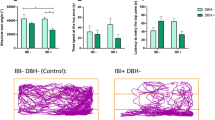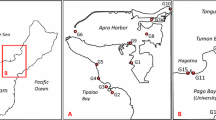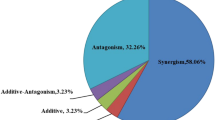Abstract
Two independent types of stressors, chemicals and high temperatures, which frequently act together in the environment, are addressed in this study. Pesticides (imidacloprid and chlorpyrifos) as well as a metal salt (nickel chloride) were investigated for their toxic effect at different temperatures. Tests focused on the early development of zebrafish (Danio rerio) embryos and larvae (from fertilization up to 168 h postfertilization) when exposed to the three respective chemicals at an optimum temperature (26°C) and three higher temperatures (up to 33.5°C). At all temperatures tested, the two pesticides did not have a significant impact on the early development of the zebrafish at the highest test concentrations (imidacloprid, 50 mg/l; chlorpyrifos, 1 mg/l). Nickel led to a significant decrease of hatching success at all temperatures; the combination of elevated temperature and nickel exposure revealed a synergistic effect of both stressors.




Similar content being viewed by others
References
CEPA (2006) California Environmental Protection Agency, Department of Pesticide Regulation: imidacloprid risk characterisation document: Dietary and drinking water exposure. Available from http://www.who.int/water_sanitation_health/dwq/chemicals/Nickel110805.pdf (accessed 17 June 2008)
Dave G, Xiu RQ (1991) Toxicity of mercury, copper, nickel, lead, and cobalt to embryos and larvae of zebrafish, Brachydanio rerio. Arch Environ Contam Toxicol 21:126–134
Gauthier C, Couture P, Pyle GG (2006) Metal effects on fathead minnows (Pimephales promelas) under field and laboratory conditions. Ecotoxicol Environ Safety 63:353–364
Hagenmaier H (1974) The hatching process in fish embryos. V. Characterization of the hatching protease (chorionase) from the perivitelline fluid of the rainbow trout, Salmo gairdneri Rich, as a metalloenzyme. Wilhelm Roux Arch 175:157–162
Hallare AV, Köhler H-R, Triebskorn R (2004) Developmental toxicity and stress protein responses in zebrafish embryos after exposure to diclofenac and its solvent, DMSO. Chemosphere 56:659–666
Hallare AV, Nagel K, Köhler H-R, Triebskorn R (2006) Comparative embryotoxicity and proteotoxicity of three carrier solvents to zebrafish (Danio rerio) embryos. Ecotoxicol Environ Safety 63:378–388
Hallare AV, Schirling M, Luckenbach T, Köhler H-R, Triebskorn R (2005) Combined effects of temperature and cadmium on developmental parameters and biomarker responses in zebrafish (Danio rerio) embryos. J Thermal Biol 30:7–17
Humphrey C, Klumpp DW (2003) Toxicity of chlorpyrifos to the early life history stages of eastern rainbowfish Melanotaenia splendida splendida (Peters 1866) in tropical Australia. Environ Toxicol 18:418–427
ICPS (1991) Environmental Health Criteria Report No. 108. Nickel. Prepared as a part of WHO’s International Programme on Chemical Safety. World Health Organization, Geneva
Jemec A, Tisler T, Drobne D, Sepcić K, Fournier D, Trebse P (2007) Comparative toxicity of imidacloprid, of its commercial liquid formulation and of diazinon to a non-target arthropod, the microcrustacean Daphnia magna. Chemosphere 68:1408–1418
Jonker MJ, Svendsen C, Bedaux JJM, Bongers M, Kammenga JE (2005) Significance testing of synergistic/antagonistic, dose level-dependent, or dose ratio-dependent effects in mixture dose-response analysis. Environ Toxicol Chem 24:2701–2713
Kamrin MA (1997) Pesticide profiles: toxicity, environmental impact, and fate. CRC Press, Boca Raton, FL
Kasprzak K (1987) Nickel. In: Fishbein L, Furst A, Mehlman M (eds) Advances in modern environmental toxicology. Princeton Scientific Publishing, Princeton, NJ, pp 145–183
Levin E, Chrysanthis E, Yacisin K, Linney E (2003) Chlorpyrifos exposure of developing zebrafish: effects on survival and long-term effects on response latency and spatial discrimination. Neurotoxicol Teratol 25:51–57
Levin E, Swain H, Donerly S, Linney E (2004) Developmental chlorpyrifos effects on hatchling zebrafish swimming behavior. Neurotoxicol Teratol 26:719–723
Marino D, Ronco A (2005) Cypermethrin and chlorpyrifos concentration levels in surface water bodies of the Pampa Ondulada, Argentina. Bull Environ Contam Toxicol 75:820–826
Mukherjee AB (1998) Nickel: a review of occurrence, uses, emissions, and concentration in the environment in Finland. Environ Rev/Dossiers Environ 6:173–187
Nagel R (2002) DarT: the embryo test with the zebrafish Danio rerio: a general model in ecotoxicology and toxicology. Altex 19(Suppl 1):38–48
Nüsslein-Volhard C, Gilmour DT, Dahm R (2002) Introduction: zebrafish as a system to study development and organogenesis. In: Nüsslein-Volhard C, Dahm R (eds) Zebrafish: a practical approach. Oxford University Press, Oxford, pp 1–5
Sanchez-Bayo F, Goka K (2005) Unexpected effects of zinc pyrithione and imidacloprid on Japanese medaka fish (Oryzias latipes). Aquat Toxicol 74:285–293
Tomizawa M, Casida J (2005) Neonicotinoid insecticide toxicology: mechanisms of selective action. Annu Rev Pharmacol Toxicol 45:247–268
Tomlin CDS (1997) The pesticide manual: a world compendium. British Crop Protection Council, Farnham, UK
US EPA (2002) Interim reregistration eligibility decision for chlorpyrifos. Report No. EPA 738-R-01-007. US Environmental Protection Agency, Washington, DC
US Geological Survey (2003) Lake Wales Ridge ground water monitoring study. Available from http://fisc.er.usgs.gov/Lake_Wales_Ridge/html/table_4.html (accessed 17 June 2008)
Wacksman MN, Maul JD, Lydy MJ (2006) Impact of atrazine on chlorpyrifos toxicity in four aquatic vertebrates. Arch Environ Contam Toxicol 51:681–689
WHO (2007) Nickel in drinking-water, background document for development of WHO guidelines for drinking-water quality. available from http://www.who.int/water_sanitation_health/dwq/chemicals/Nickel110805.pdf (accessed 17 June 2008)
Acknowledgments
The study was supported by the EU Integrated project NoMiracle (Novel Methods for Integrated Risk Assessment of Cumulative Stressors in Europe; http://nomiracle.jrc.it) contract No. 003956 under the EU theme “Global Change and Ecosystems” topic “Development of risk assessment methodologies,” coordinated by Dr. Hans Løkke at NERI, DK-8600 Silkeborg, Denmark. The authors wish to thank Christopher Harvey for helpful comments on the manuscript.
Author information
Authors and Affiliations
Corresponding author
Rights and permissions
About this article
Cite this article
Scheil, V., Köhler, HR. Influence of Nickel Chloride, Chlorpyrifos, and Imidacloprid in Combination with Different Temperatures on the Embryogenesis of the Zebrafish Danio rerio . Arch Environ Contam Toxicol 56, 238–243 (2009). https://doi.org/10.1007/s00244-008-9192-8
Received:
Accepted:
Published:
Issue Date:
DOI: https://doi.org/10.1007/s00244-008-9192-8




